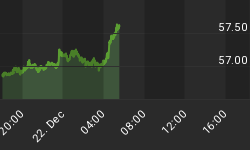The following is part of Pivotal Events that was published for our subscribers Thursday, April 3, 2008.
SIGNS OF THE TIMES:
Last Year:
"Horsepower Nation: New Car Models Boast Speed, Size, Power"
"While Washington Buzzes About Biofuel, at New York Auto Show, Big is Beautiful."
- Wall Street Journal, April 5, 2007
Chrysler, for example, has been making big cars and is now shutting down shifts.
"Investors Regain Their Risk Hunger"
- Wall Street Journal, April 16, 2007
That headline featured a cartoon of a fund manager diving towards a treasure chest - with sharks circling around.
Perhaps the following is one of the great ones from any bull market:
"More Professors Are Lured Out of Ivory Tower to Wall Street"
- Wall Street Journal, April 21
This compares with the classic observation by veteran journalist Alexander Dana Noyes after the 1929 crash:
"1901 was . . . speculative demonstration based . . . on the assumption that we were living in a new era; that old rules and principles and precedent of finance were obsolete; that things could safely be done to-day which had been dangerous or impossible in the past. The illusion seized on the public mind in 1901 quite as firmly as it did in 1929. It differed only in the fact that there were no college professors in 1901 who preached the popular illusion as their new political economy."
* * * * *
This Year:
"Copper Price to Soar as Surpluses Turn to Deficits"
- Financial Post, March 28, 2008--based upon a UBS study
"High Prices Spark Fresh Gold Rush in California"
"Prospector's once again flocking to the state's deserts and rivers in search of the precious metal."
- Financial Times, March 28, 2008
"Grain is the New Copper"
"Thieves in pickups hit farms."
- Financial Post, March 28, 2008
* * * * *
Stock Markets: Early in the week, the feature was rotation as the shorts got squeezed in the banks, and the longs got pummeled in commodity sectors.
Bank stocks are rallying as if there was no yesterday, and this is giving the senior stock indexes quite a lift.
Overall, this seems to be fitting into our view formed in the worst of the January panic. This was that the market had suffered a classic 55-day hit and that the rebound should run into March, which would make the policymakers and their desperate remedies look good.
Well, it took a second hit and an even more urgent set of nostrums -- and, by jing, in only a few days - they are, indeed looking good. For how long?
As noted in our March 13 edition, there had been a couple of "one-and-a-half-day" wonders, but it seemed to be working on a test of the January disaster and that a rebound of a few weeks could follow. This we are getting and those who did not anticipate, or do not as yet understand the nature of credit contractions are saying that the distress is over.
However, trading volume, advance/declines and buying power are not robust (well, Tuesday's action achieved a 90% up day), which suggests this rally is precarious. In which case, we watch for the overbought condition that will limit the move and at the same time tell us that the market is again vulnerable. This could occur within the next few weeks.
Sector Comment: Our comment last week was that the spike up in banks could be sold. Perhaps, the "aggressively" part was a little early. A Canadian bank analyst pointed out that the stock yield relative to the 10-year bond is "seven standard deviations away from the mean". This was taken as indicative of "superior" value, but we would take it as an indication of instability that can still be dangerous. The methodology is a variation on the so-called "Fed Model", which, like so many of its products - isn't worth the paper it's printed on.
Bank dividends, such as they are, are very precarious and the 10-year note can go up in yield quite a bit.
Ross has improved our proprietary Bank Trading Guide by adding an RSI to it, which in early March got high enough to give a "sell" signal. The ChartWorks on this will be sent separately and the pattern is that following the signal, banks continue to rally and usually set the key high some three weeks later.
This is the week that a rally could top out and roll over.















